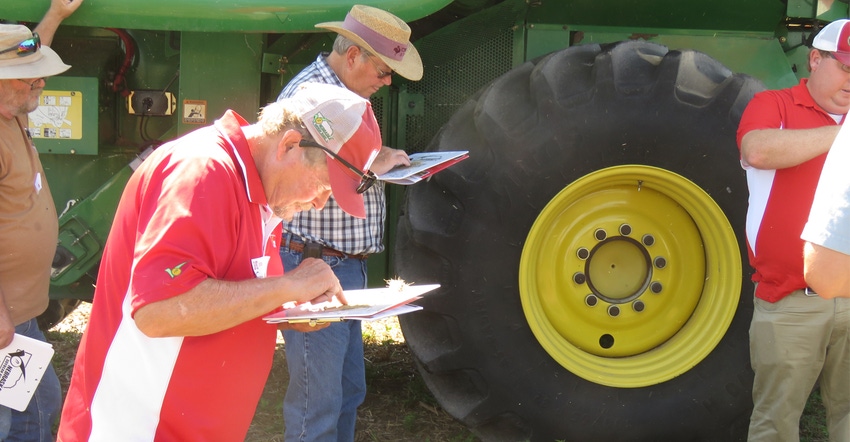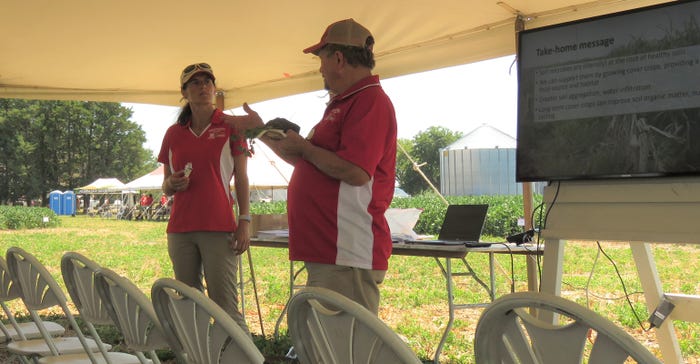August 22, 2022

Where can you learn about pathology, cover crops, weed management, ag economics and renewable diesel? Most people wouldn’t guess it would in the middle of a soybean field.
But that is where learning and conversing happened Aug. 11 at the Daryl Obermeier fam near Brownville, Neb., at a Soybean Management Field Days event, collaborated by Nebraska Extension and the Nebraska Soybean Board.
This field day made history as it was the first Soybean Management Field Days event that was completely dryland. Other events were held the same week at sites near Blue Hill, Central City and Decatur.
Beating weeds
One of the challenging topics that was covered this field day was weed management, as waterhemp and Palmer amaranth consumed fields this year. Dan Smith, University of Wisconsin-Madison Extension agronomist, and Chris Proctor, Nebraska weed management Extension educator, told producers that these two different weeds look very similar, but small things separate them.
The biggest difference is that waterhemp’s seed head is smaller than Palmer amaranth. Waterhemp will have about 200,000 seeds per plant compared to Palmer amaranth, which has about 400,000 seeds.

KEEP IT CLEAN: One of the best ways to prevent outbreaks of challenging weeds such as Palmer amaranth and waterhemp is by thoroughly cleaning the combine, which can be done effectively in about 30 minutes if the operation is focused in the right places.
Knowing the caliber of seeds that these plants carry, it is important to take preventive measures to keep these weed seeds out of fields. The biggest carrier of weed seeds is the combine itself. These weed seeds can hide in a lot of places in the machine, so knowing where to focus combine cleaning is important.
The question was asked, how many acres of soybeans can you harvest in 30 minutes? The average answer was about 6 acres. In that same amount of time, you can clean your combine focusing mostly on the head, feeder house and rock trap. By doing this, you can eliminate hand-weeding, failed herbicide attempts, tillage and yield loss.
Cover crops
A site-specific topic to the Brownville site was cover crops as Daryl Obermeyer, owner of the land for this field day, integrates a variety of cover crops into his operation. Katja Koehler-Cole, Nebraska soil health management Extension educator, gave a presentation on how soil microbes benefit from cover crops.
There are five main soil health principles that will create a healthy soil, Koehler-Cole said. These include keeping it covered, not disturbing it, living roots year-round, diverse plants creating a diverse microbe community and integrating livestock.
“We can check off so many of the soil health principles just by planting a cover crop,” Koehler-Cole said.

COVER CROPS: Katja Koehler-Cole, Nebraska soil health Extension educator, and Gary Lesoing, Nebraska water and crops Extension educator, demonstrate how soil health is improved by utilizing cover crops.
Soil organic matter results are the best and easiest way to assess soil health. The way to attain more organic matter is by having many microbes in the soil. These microbes help with nutrient cycling, water infiltration, water retention and soil structure.
Koehler-Cole passed around different soils, one with cover crops in the management plan and one without cover crops. The sample without cover crops fell apart quickly and left the roots exposed. However, when looking at the cover crop example, it stayed together well and even had some earthworm holes throughout the soil. This all goes back to the soil principles that a producer can meet when planting cover crops.
Other topics covered at the event included insect and disease management, irrigation management at the other sites, along with precision agriculture implications and renewable fuels. Obermeyer said, “Several Extension employees show dedication for producers by showing their research.”
Not only is this an educational experience, but farmers also are able to collaborate and visit with graduate students from UNL and other professionals at these events. Learn more at extension.unl.edu.
You May Also Like




